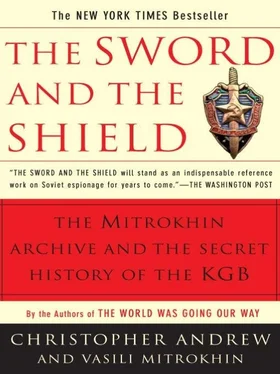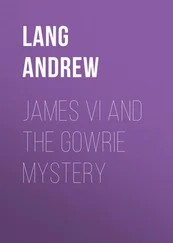A conference of the KGB leadership in May 1981 included in its main priorities the recruitment of agents from the cipher personnel of the United States, Britain, France, West Germany and China. Andropov reaffirmed that priority in a special directive issued after he succeeded Brezhnev as general secretary in 1982. 76He also approved the secret award of the Order of the Friendship of Peoples to the KGB’s longest-serving cipher officer agent, JOUR in the French foreign ministry, in recognition of his “long and fruitful co-operation” over the previous thirty-seven years. 77The FCD Sixteenth Department, headed by A. V. Krasavin, had plans to create another forty or fifty intercept posts in Soviet establishments around the world by the end of the decade. It calculated optimistically that the volume of intercepted communications would increase by five to eight times its present level if the current rate of expansion were maintained. 78
According to Viktor Makarov, who served in the Sixteenth Directorate from 1980 to 1986, the European states whose diplomatic traffic was decrypted with varying frequency during these years included Denmark, Finland, France, Greece, Italy, Sweden, Switzerland and West Germany. There was, he believes, no penetration of high-grade British cipher systems during that period. 79An inner circle within the Politburo—consisting, in 1980, of Brezhnev, Andropov, Gromyko, Kirilenko, Suslov and Ustinov—were sent a daily selection of the most important intercepts. A larger selection was forwarded each day to the heads of the First and Second Chief Directorates. 80Though neither selection is yet available for research, both will one day be sources of major importance for historians of Soviet foreign policy.
In addition to obviously important items such as Kissinger’s and Vance’s meetings with foreign leaders, the intercepts selected for the inner circle of the Politburo undoubtedly also included, whenever possible, Western responses to their public pronouncements. Vyacheslav Ivanovich Gurgenev (alias “Artemov”), deputy head of the FCD, complained publicly in 1991:
Our service has had enough trouble in the past trying to collect responses to every “brilliant” initiative by our leaders. This kind of work tended to corrupt people who started out with the illusion of doing something useful. 81
Residencies around the world were expected to provide prompt reports of favorable responses to every major speech by the Soviet leadership. When no such responses occurred, they were commonly invented to avoid the risk of offending the Politburo. 82Since the Sixteenth Directorate was able, by the later 1960s, to decrypt at least some of the diplomatic traffic of over seventy states, 83its chances of finding some suitable response among the thousands of decrypts produced each week were much greater than those of even the most active residency.
In the pre -glasnost era controversial references to Soviet leaders were routinely edited out of translations of diplomatic decrypts. Makarov recalls seeing an intercepted cable from the Swedish ambassador in Moscow in August 1984 discussing the likely power struggle which would follow the demise of the ailing Konstantin Chernenko. Among the passages removed or doctored in the Russian translation was a disparaging reference to Gorbachev’s wife, Raisa Maximovna. On another occasion Makarov was ordered to remove from a diplomatic telegram he had decrypted the sentence, “Gorbachev is like Andropov.” Such excisions were known within the Sixteenth Directorate as “minding the words.” 84
DURING THE 1980s SIGINT agencies in both East and West began to face two formidable new technological challenges: the use of fiber optics in global telecommunications and the greatly increased availability of highly sophisticated encryption systems. Neither the KGB nor any other SIGINT agency seems to have devised a system of intercepting messages which passed along fiber-optic lines as streams of light. In the late 1980s Britain installed a highly secure fiber-optic trunk system, codenamed BOXER, which linked 200 military installations. Simultaneously, the development of Public Key Cryptography by mathematicians at the Massachusetts Institute of Technology and the Weizmann Institute in Israel, and subsequent refinements such as Phil Zimmermann’s PGP (Pretty Good Privacy) system, made ciphers which were difficult, if not impossible, for SIGINT agencies to crack, available to anyone with a powerful desktop computer and modem. 85
The SIGINT-related files seen by Mitrokhin, which end in 1982, do not explain how the KGB sought to respond to these new challenges. It is clear from other evidence, however, that Soviet SIGINT operations continued to expand, at least in volume, during the Gorbachev era. Those of the GRU, targeted chiefly on the armed forces of the United States, NATO and China, were on an even larger scale than the KGB’s. By the end of the 1980s the Red Army had 40 SIGINT regiments, 170 SIGINT battalions and over 700 SIGINT companies. Since the launch of Kosmos 189 in 1967, the GRU Space Intelligence Directorate had put over 130 SIGINT satellites into orbit. More than 60 Soviet surface ships and over 20 different types of aircraft were used for SIGINT collection. The GRU and KGB had between them over 500 SIGINT ground stations in the Soviet Union and around the world. In all, the GRU and KGB SIGINT network probably employed about 350,000 intercept operators, processors, cryptanalysts and other technical specialists, a majority of them military personnel—about five times as many as the NSA and US Service Cryptological Authorities, which together had an estimated 60,000 to 70,000 personnel. 86According to Vladimir Rubakov, a senior KGB officer interviewed shortly before the reorganization of Soviet intelligence in 1991, SIGINT operations consumed a quarter of the KGB budget. 87
In December 1991 the former Eighth and Sixteenth Directorates of the KGB were reconstituted as an independent service, the Federal Agency for Government Communications and Information (FAPSI in its Russian acronym), responsible for communications security, ciphers and SIGINT. Russian SIGINT operations today are on a significantly smaller scale than those of the former Soviet Union. One of the least noticed consequences of the disintegration of the Soviet Bloc was the dismantling of the great majority of the 150 ground stations in former Warsaw Pact countries. 88Some of the most important stations outside the Russian Federation, however, still survive—among them the large SIGINT complexes near Tallinn in Estonia and at Lourdes in Cuba (though the Lourdes personnel was reduced by over half to a total of about 1,000 in 1993). 89The residencies of the SVR, the Russian foreign intelligence service, continue to contain active intercept posts. Though FAPSI operates with somewhat reduced resources, faces harder targets and probably finds it increasingly difficult to match NSA’s state of the art technology, Russian SIGINT still has a global reach.
TWENTY-TWO
SPECIAL TASKS
Part 1: From Marshal Tito to Rudolf Nureyev
Assassination had been an integral part of Stalin’s foreign policy. During the late 1930s he had been obsessed with NKVD operations to liquidate Trotsky and his leading foreign supporters. The final act of his foreign policy before he died in 1953 was a plan to assassinate Josip Tito, who had succeeded Trotsky as the leading heretic of the Soviet Bloc.
At the height of the Terror, Tito (born Josip Broz) had, ironically, been one of the few leading Yugoslav Communists (most then living in exile in Moscow) who were trusted by the NKVD. On becoming secretary general of the purged Yugoslav Party in 1937, he had dutifully denounced his persecuted and liquidated comrades, in impeccable Stalinist invective, as Trotskyists, traitors, factionalists, spies and anti-Party elements. He apologized personally to Stalin for his own lack of vigilance in choosing as his first wife a woman who had since been unmasked as an (imaginary) Gestapo agent. When Tito became wartime leader of the Communist partisans, an NKVD agent, Josip Kopinić, codenamed VAZHDUH (“Air”), acted as his radio link with Moscow. 1At the end of the war, the NKGB resident, Saveli Vladimirovich Burtakov (codenamed LIST), presented the head of Tito’s Bureau of People’s Protection, Alexander-Leka Ranković, with a portrait of Stalin. Apparently deeply moved, Ranković (codenamed MARKO by the Centre) replied that it was the most precious gift he could possibly have received. 2There was no sign yet of the violent confrontation between Tito and Stalin which was to erupt only three years later. Despite his own subsequent loathing for Stalinism, the leading Yugoslav communist Milovan Djilas later acknowledged:
Читать дальше











